Childcare Assignment: Philosophy and Curriculum Analysis Report
VerifiedAdded on 2021/06/15
|23
|4603
|490
Report
AI Summary
This report delves into the student's personal philosophy on childcare, emphasizing the importance of child-centered learning and the educator's role in fostering positive learning experiences. It highlights the significance of setting goals, focusing on children's needs, and encouraging their active participation in the educational process. The report then analyzes three curriculum approaches: Reggio Emilia, Montessori, and High/Scope, comparing and contrasting their methods and how they align with the student's personal philosophy. The analysis includes daily routines, program formats, and the role of families and children in the curriculum planning process. The report also examines how these approaches reflect the student's views on children and educators, and how they address individual and group needs within the learning environment. The student reflects on the strengths and weaknesses of each approach, providing a comprehensive overview of childcare philosophies and their practical applications.
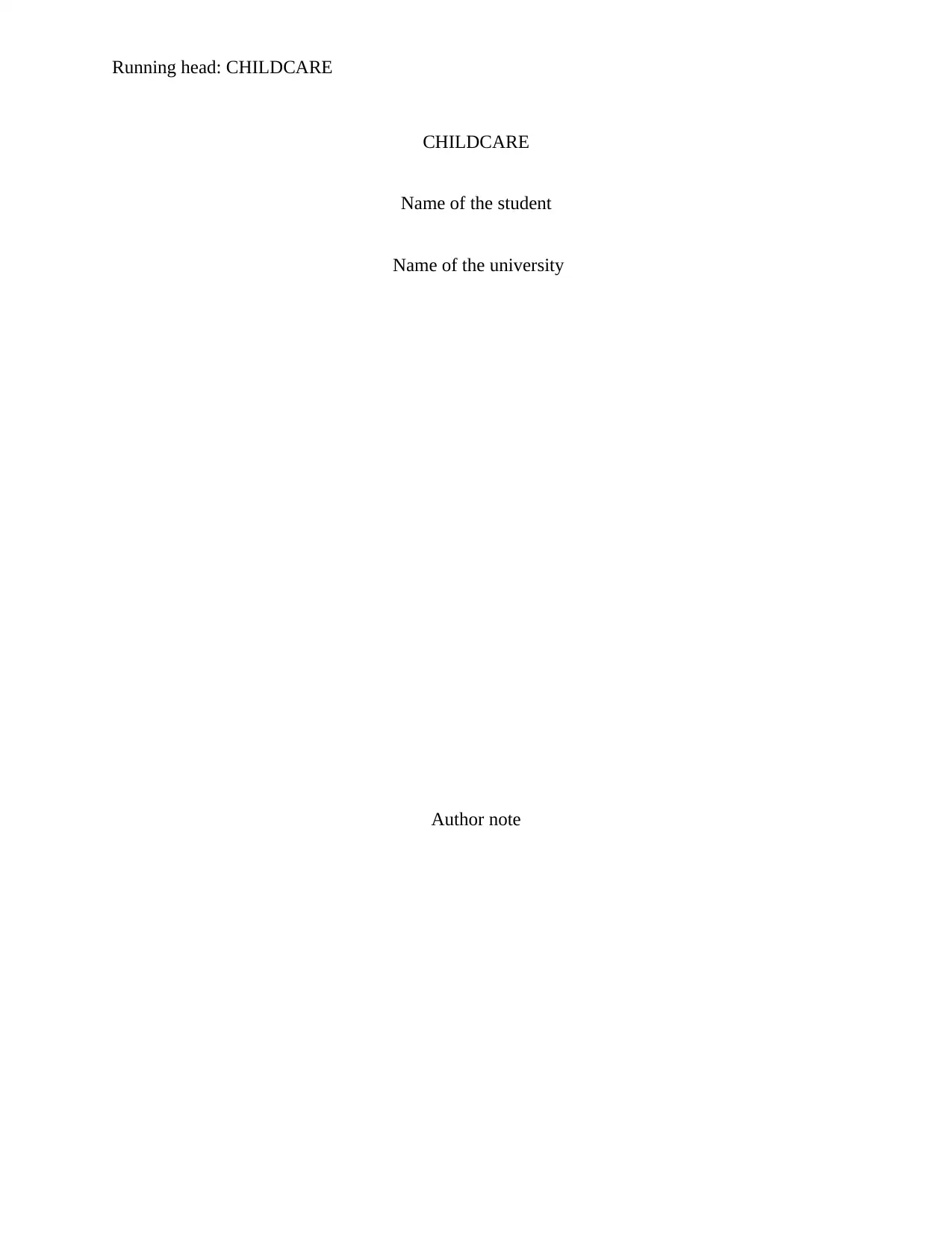
Running head: CHILDCARE
CHILDCARE
Name of the student
Name of the university
Author note
CHILDCARE
Name of the student
Name of the university
Author note
Paraphrase This Document
Need a fresh take? Get an instant paraphrase of this document with our AI Paraphraser
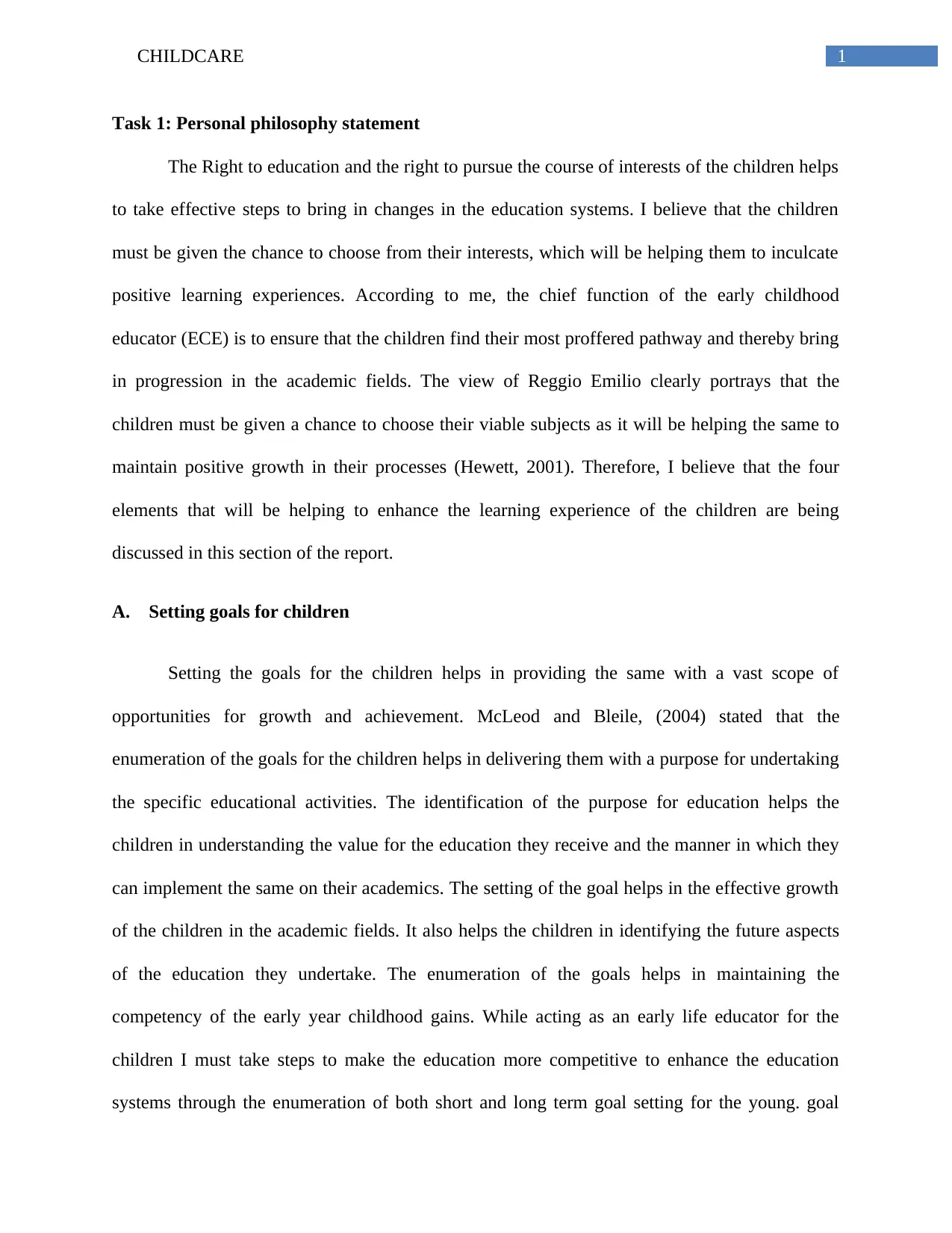
1CHILDCARE
Task 1: Personal philosophy statement
The Right to education and the right to pursue the course of interests of the children helps
to take effective steps to bring in changes in the education systems. I believe that the children
must be given the chance to choose from their interests, which will be helping them to inculcate
positive learning experiences. According to me, the chief function of the early childhood
educator (ECE) is to ensure that the children find their most proffered pathway and thereby bring
in progression in the academic fields. The view of Reggio Emilio clearly portrays that the
children must be given a chance to choose their viable subjects as it will be helping the same to
maintain positive growth in their processes (Hewett, 2001). Therefore, I believe that the four
elements that will be helping to enhance the learning experience of the children are being
discussed in this section of the report.
A. Setting goals for children
Setting the goals for the children helps in providing the same with a vast scope of
opportunities for growth and achievement. McLeod and Bleile, (2004) stated that the
enumeration of the goals for the children helps in delivering them with a purpose for undertaking
the specific educational activities. The identification of the purpose for education helps the
children in understanding the value for the education they receive and the manner in which they
can implement the same on their academics. The setting of the goal helps in the effective growth
of the children in the academic fields. It also helps the children in identifying the future aspects
of the education they undertake. The enumeration of the goals helps in maintaining the
competency of the early year childhood gains. While acting as an early life educator for the
children I must take steps to make the education more competitive to enhance the education
systems through the enumeration of both short and long term goal setting for the young. goal
Task 1: Personal philosophy statement
The Right to education and the right to pursue the course of interests of the children helps
to take effective steps to bring in changes in the education systems. I believe that the children
must be given the chance to choose from their interests, which will be helping them to inculcate
positive learning experiences. According to me, the chief function of the early childhood
educator (ECE) is to ensure that the children find their most proffered pathway and thereby bring
in progression in the academic fields. The view of Reggio Emilio clearly portrays that the
children must be given a chance to choose their viable subjects as it will be helping the same to
maintain positive growth in their processes (Hewett, 2001). Therefore, I believe that the four
elements that will be helping to enhance the learning experience of the children are being
discussed in this section of the report.
A. Setting goals for children
Setting the goals for the children helps in providing the same with a vast scope of
opportunities for growth and achievement. McLeod and Bleile, (2004) stated that the
enumeration of the goals for the children helps in delivering them with a purpose for undertaking
the specific educational activities. The identification of the purpose for education helps the
children in understanding the value for the education they receive and the manner in which they
can implement the same on their academics. The setting of the goal helps in the effective growth
of the children in the academic fields. It also helps the children in identifying the future aspects
of the education they undertake. The enumeration of the goals helps in maintaining the
competency of the early year childhood gains. While acting as an early life educator for the
children I must take steps to make the education more competitive to enhance the education
systems through the enumeration of both short and long term goal setting for the young. goal
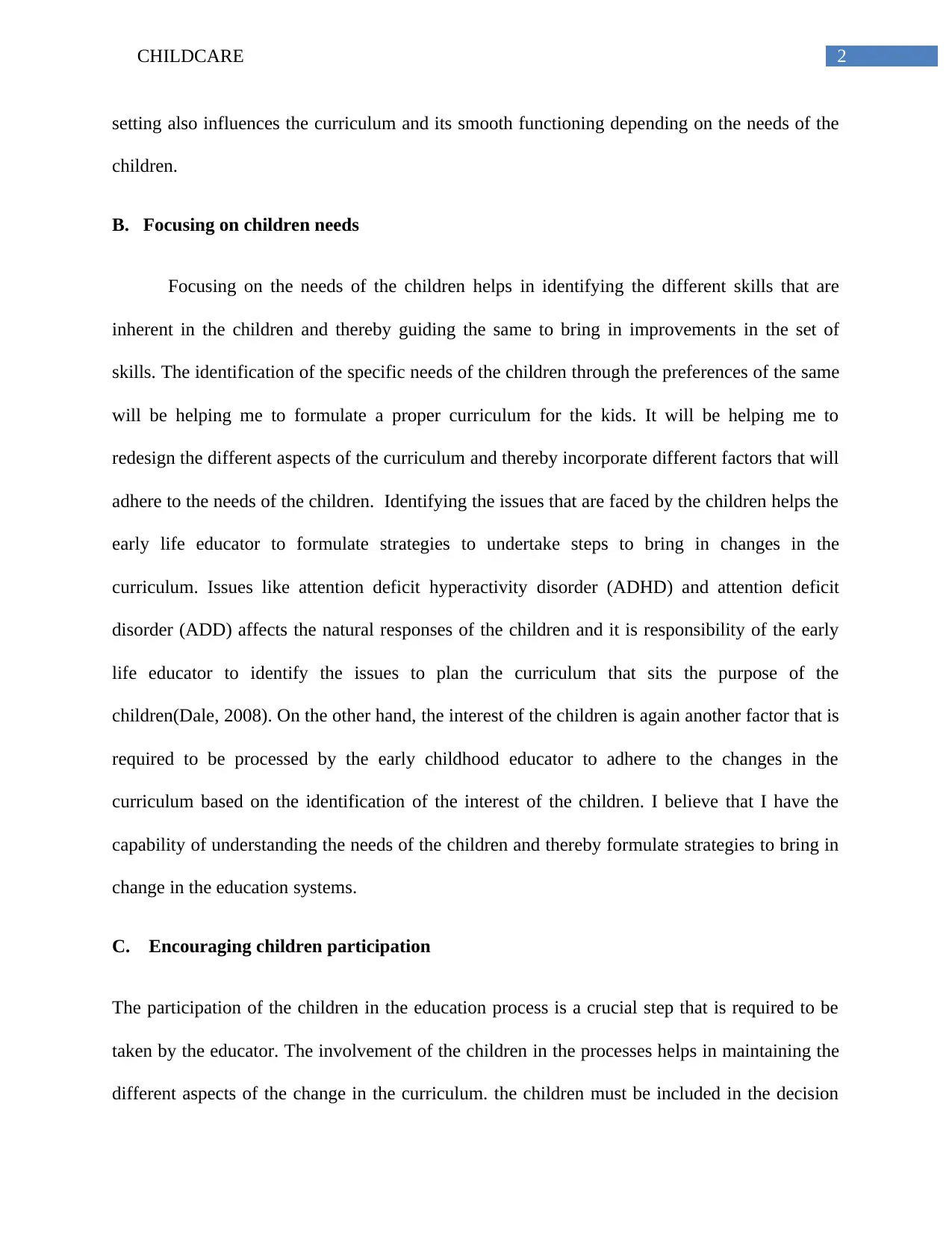
2CHILDCARE
setting also influences the curriculum and its smooth functioning depending on the needs of the
children.
B. Focusing on children needs
Focusing on the needs of the children helps in identifying the different skills that are
inherent in the children and thereby guiding the same to bring in improvements in the set of
skills. The identification of the specific needs of the children through the preferences of the same
will be helping me to formulate a proper curriculum for the kids. It will be helping me to
redesign the different aspects of the curriculum and thereby incorporate different factors that will
adhere to the needs of the children. Identifying the issues that are faced by the children helps the
early life educator to formulate strategies to undertake steps to bring in changes in the
curriculum. Issues like attention deficit hyperactivity disorder (ADHD) and attention deficit
disorder (ADD) affects the natural responses of the children and it is responsibility of the early
life educator to identify the issues to plan the curriculum that sits the purpose of the
children(Dale, 2008). On the other hand, the interest of the children is again another factor that is
required to be processed by the early childhood educator to adhere to the changes in the
curriculum based on the identification of the interest of the children. I believe that I have the
capability of understanding the needs of the children and thereby formulate strategies to bring in
change in the education systems.
C. Encouraging children participation
The participation of the children in the education process is a crucial step that is required to be
taken by the educator. The involvement of the children in the processes helps in maintaining the
different aspects of the change in the curriculum. the children must be included in the decision
setting also influences the curriculum and its smooth functioning depending on the needs of the
children.
B. Focusing on children needs
Focusing on the needs of the children helps in identifying the different skills that are
inherent in the children and thereby guiding the same to bring in improvements in the set of
skills. The identification of the specific needs of the children through the preferences of the same
will be helping me to formulate a proper curriculum for the kids. It will be helping me to
redesign the different aspects of the curriculum and thereby incorporate different factors that will
adhere to the needs of the children. Identifying the issues that are faced by the children helps the
early life educator to formulate strategies to undertake steps to bring in changes in the
curriculum. Issues like attention deficit hyperactivity disorder (ADHD) and attention deficit
disorder (ADD) affects the natural responses of the children and it is responsibility of the early
life educator to identify the issues to plan the curriculum that sits the purpose of the
children(Dale, 2008). On the other hand, the interest of the children is again another factor that is
required to be processed by the early childhood educator to adhere to the changes in the
curriculum based on the identification of the interest of the children. I believe that I have the
capability of understanding the needs of the children and thereby formulate strategies to bring in
change in the education systems.
C. Encouraging children participation
The participation of the children in the education process is a crucial step that is required to be
taken by the educator. The involvement of the children in the processes helps in maintaining the
different aspects of the change in the curriculum. the children must be included in the decision
⊘ This is a preview!⊘
Do you want full access?
Subscribe today to unlock all pages.

Trusted by 1+ million students worldwide
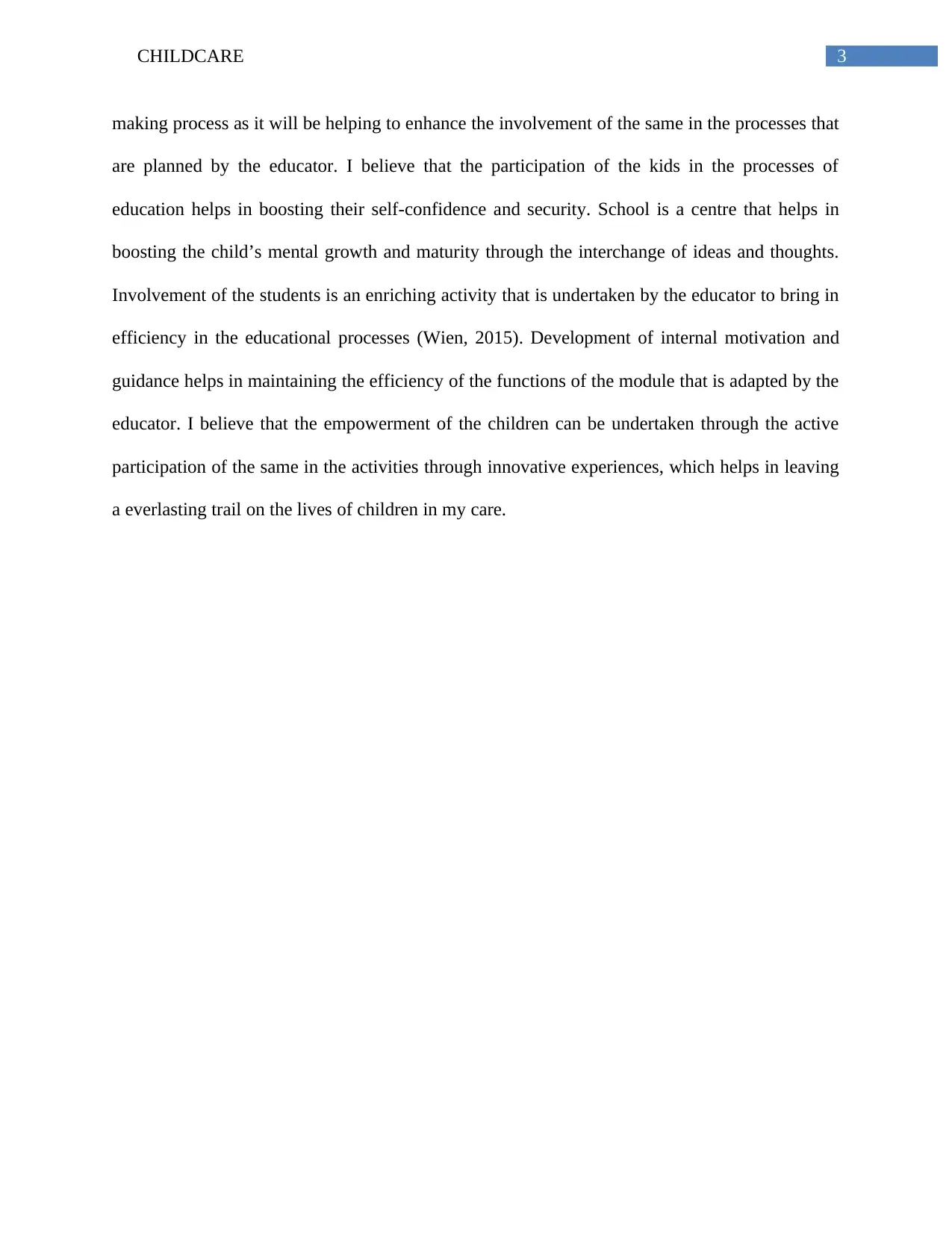
3CHILDCARE
making process as it will be helping to enhance the involvement of the same in the processes that
are planned by the educator. I believe that the participation of the kids in the processes of
education helps in boosting their self-confidence and security. School is a centre that helps in
boosting the child’s mental growth and maturity through the interchange of ideas and thoughts.
Involvement of the students is an enriching activity that is undertaken by the educator to bring in
efficiency in the educational processes (Wien, 2015). Development of internal motivation and
guidance helps in maintaining the efficiency of the functions of the module that is adapted by the
educator. I believe that the empowerment of the children can be undertaken through the active
participation of the same in the activities through innovative experiences, which helps in leaving
a everlasting trail on the lives of children in my care.
making process as it will be helping to enhance the involvement of the same in the processes that
are planned by the educator. I believe that the participation of the kids in the processes of
education helps in boosting their self-confidence and security. School is a centre that helps in
boosting the child’s mental growth and maturity through the interchange of ideas and thoughts.
Involvement of the students is an enriching activity that is undertaken by the educator to bring in
efficiency in the educational processes (Wien, 2015). Development of internal motivation and
guidance helps in maintaining the efficiency of the functions of the module that is adapted by the
educator. I believe that the empowerment of the children can be undertaken through the active
participation of the same in the activities through innovative experiences, which helps in leaving
a everlasting trail on the lives of children in my care.
Paraphrase This Document
Need a fresh take? Get an instant paraphrase of this document with our AI Paraphraser
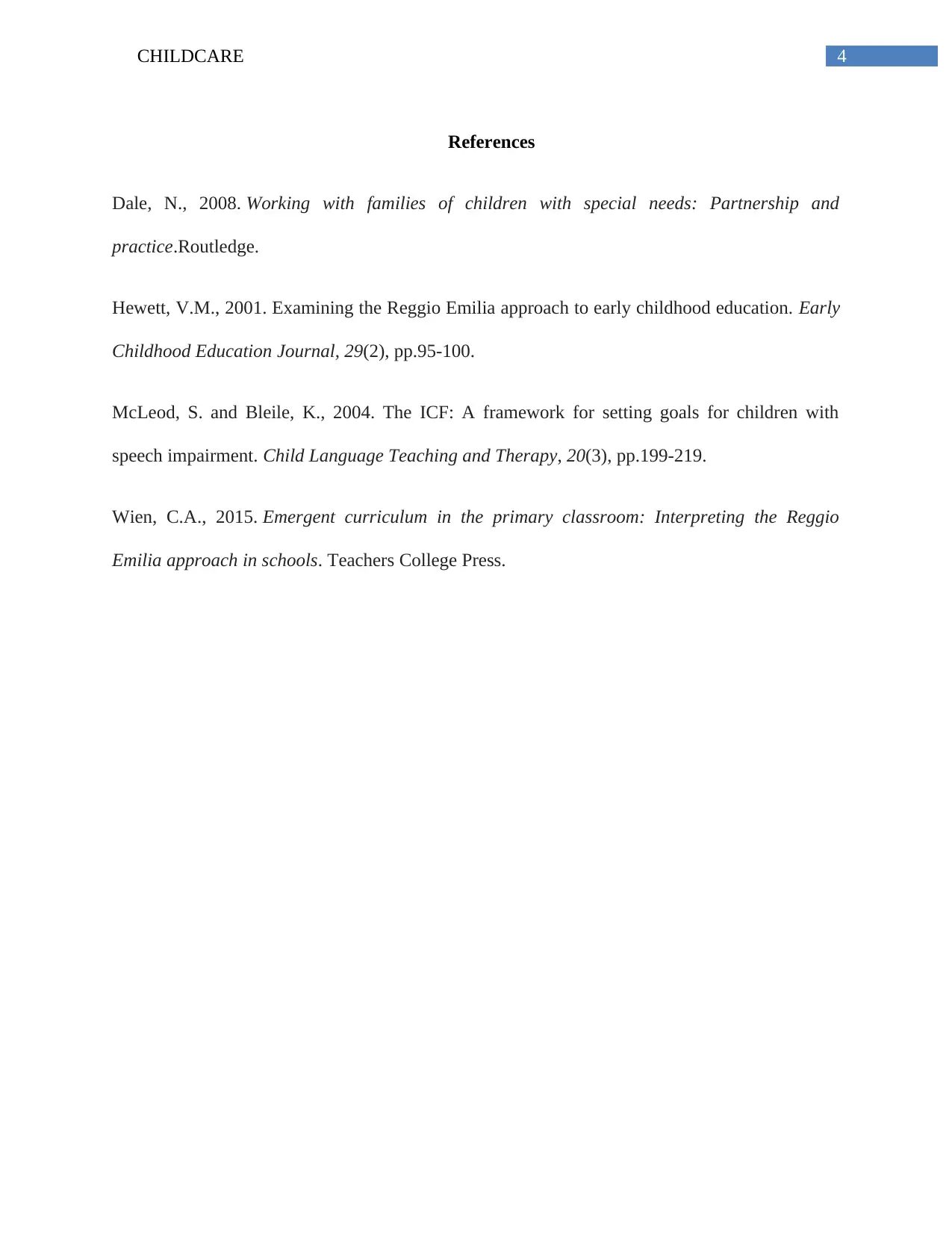
4CHILDCARE
References
Dale, N., 2008. Working with families of children with special needs: Partnership and
practice.Routledge.
Hewett, V.M., 2001. Examining the Reggio Emilia approach to early childhood education. Early
Childhood Education Journal, 29(2), pp.95-100.
McLeod, S. and Bleile, K., 2004. The ICF: A framework for setting goals for children with
speech impairment. Child Language Teaching and Therapy, 20(3), pp.199-219.
Wien, C.A., 2015. Emergent curriculum in the primary classroom: Interpreting the Reggio
Emilia approach in schools. Teachers College Press.
References
Dale, N., 2008. Working with families of children with special needs: Partnership and
practice.Routledge.
Hewett, V.M., 2001. Examining the Reggio Emilia approach to early childhood education. Early
Childhood Education Journal, 29(2), pp.95-100.
McLeod, S. and Bleile, K., 2004. The ICF: A framework for setting goals for children with
speech impairment. Child Language Teaching and Therapy, 20(3), pp.199-219.
Wien, C.A., 2015. Emergent curriculum in the primary classroom: Interpreting the Reggio
Emilia approach in schools. Teachers College Press.
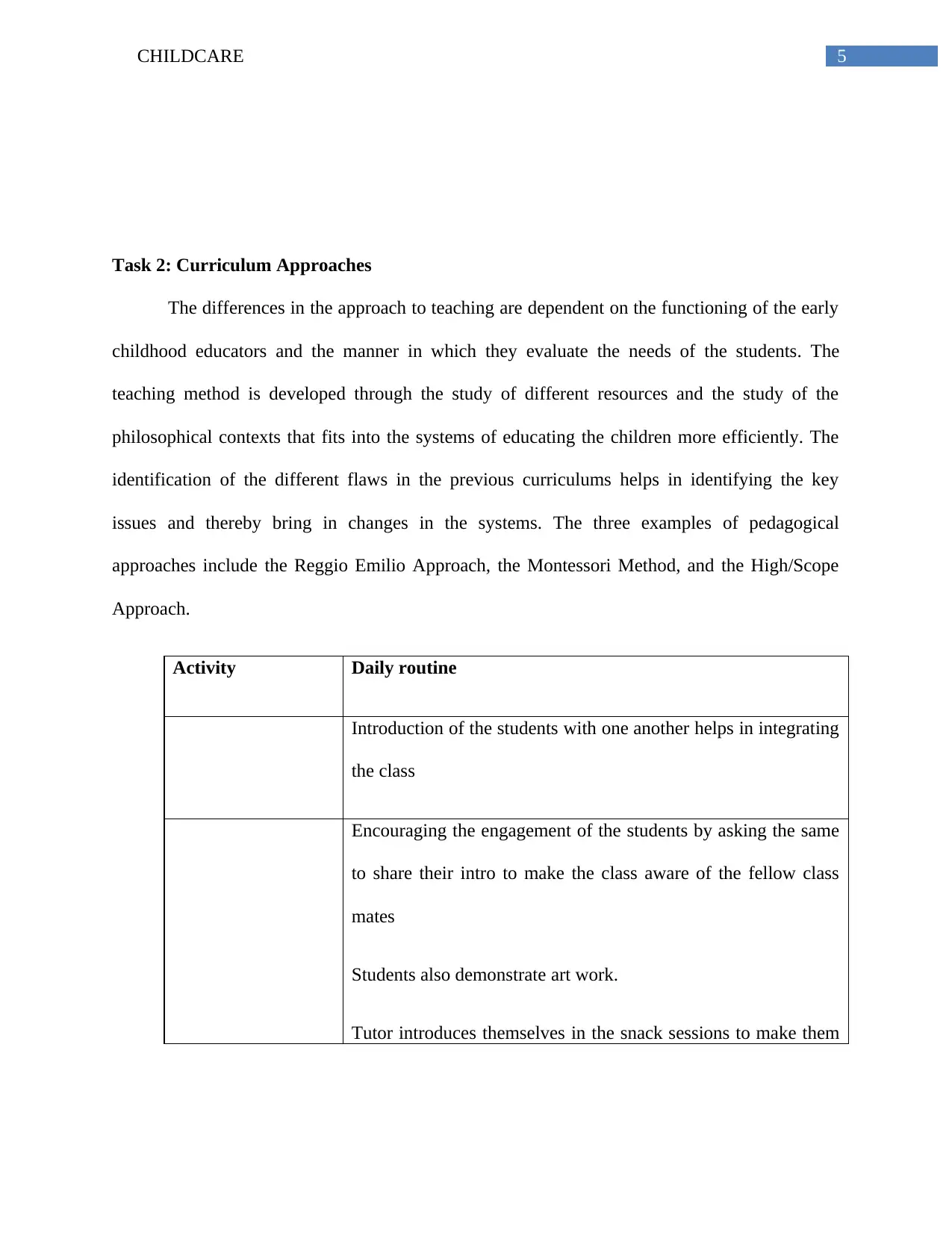
5CHILDCARE
Task 2: Curriculum Approaches
The differences in the approach to teaching are dependent on the functioning of the early
childhood educators and the manner in which they evaluate the needs of the students. The
teaching method is developed through the study of different resources and the study of the
philosophical contexts that fits into the systems of educating the children more efficiently. The
identification of the different flaws in the previous curriculums helps in identifying the key
issues and thereby bring in changes in the systems. The three examples of pedagogical
approaches include the Reggio Emilio Approach, the Montessori Method, and the High/Scope
Approach.
Activity Daily routine
Introduction of the students with one another helps in integrating
the class
Encouraging the engagement of the students by asking the same
to share their intro to make the class aware of the fellow class
mates
Students also demonstrate art work.
Tutor introduces themselves in the snack sessions to make them
Task 2: Curriculum Approaches
The differences in the approach to teaching are dependent on the functioning of the early
childhood educators and the manner in which they evaluate the needs of the students. The
teaching method is developed through the study of different resources and the study of the
philosophical contexts that fits into the systems of educating the children more efficiently. The
identification of the different flaws in the previous curriculums helps in identifying the key
issues and thereby bring in changes in the systems. The three examples of pedagogical
approaches include the Reggio Emilio Approach, the Montessori Method, and the High/Scope
Approach.
Activity Daily routine
Introduction of the students with one another helps in integrating
the class
Encouraging the engagement of the students by asking the same
to share their intro to make the class aware of the fellow class
mates
Students also demonstrate art work.
Tutor introduces themselves in the snack sessions to make them
⊘ This is a preview!⊘
Do you want full access?
Subscribe today to unlock all pages.

Trusted by 1+ million students worldwide
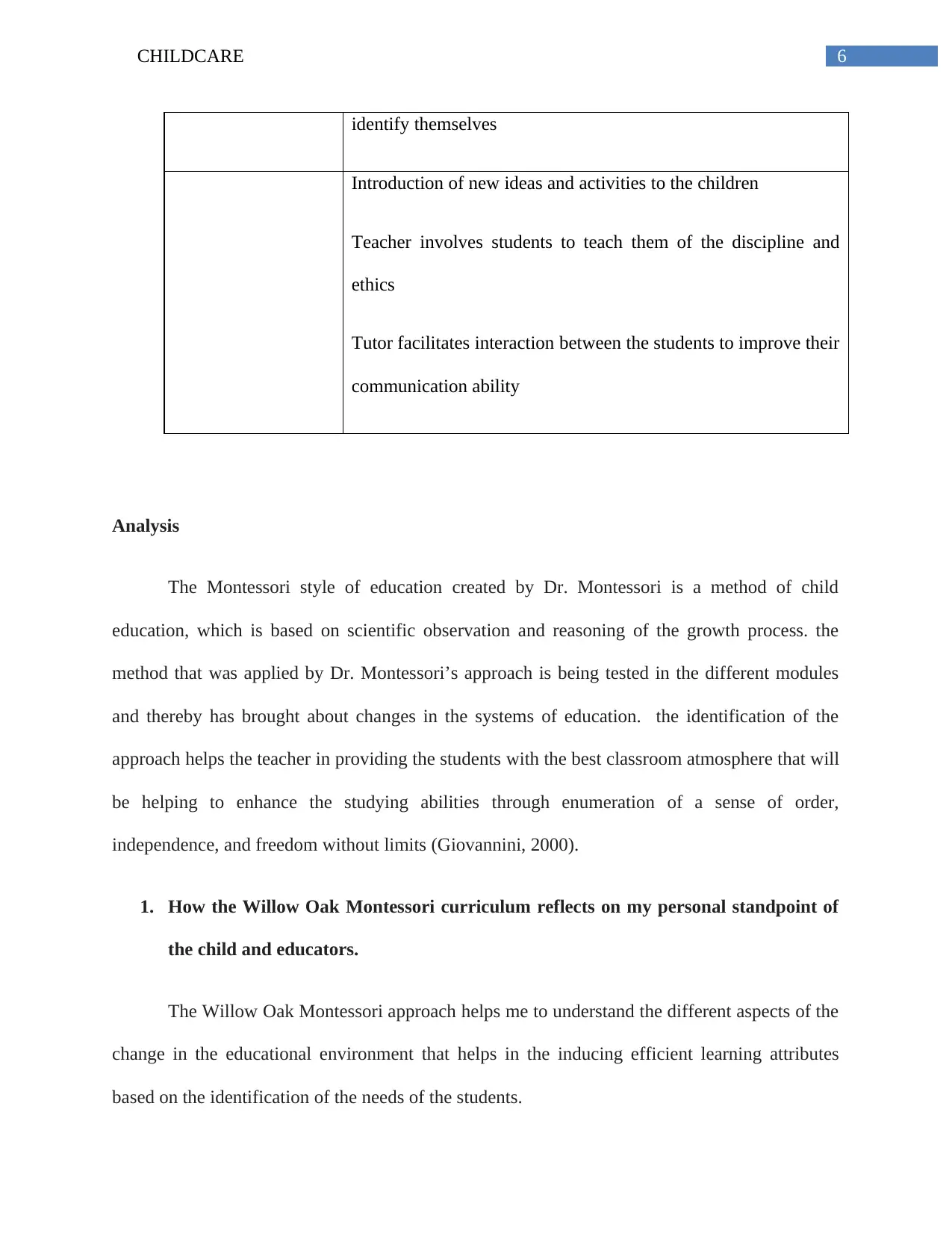
6CHILDCARE
identify themselves
Introduction of new ideas and activities to the children
Teacher involves students to teach them of the discipline and
ethics
Tutor facilitates interaction between the students to improve their
communication ability
Analysis
The Montessori style of education created by Dr. Montessori is a method of child
education, which is based on scientific observation and reasoning of the growth process. the
method that was applied by Dr. Montessori’s approach is being tested in the different modules
and thereby has brought about changes in the systems of education. the identification of the
approach helps the teacher in providing the students with the best classroom atmosphere that will
be helping to enhance the studying abilities through enumeration of a sense of order,
independence, and freedom without limits (Giovannini, 2000).
1. How the Willow Oak Montessori curriculum reflects on my personal standpoint of
the child and educators.
The Willow Oak Montessori approach helps me to understand the different aspects of the
change in the educational environment that helps in the inducing efficient learning attributes
based on the identification of the needs of the students.
identify themselves
Introduction of new ideas and activities to the children
Teacher involves students to teach them of the discipline and
ethics
Tutor facilitates interaction between the students to improve their
communication ability
Analysis
The Montessori style of education created by Dr. Montessori is a method of child
education, which is based on scientific observation and reasoning of the growth process. the
method that was applied by Dr. Montessori’s approach is being tested in the different modules
and thereby has brought about changes in the systems of education. the identification of the
approach helps the teacher in providing the students with the best classroom atmosphere that will
be helping to enhance the studying abilities through enumeration of a sense of order,
independence, and freedom without limits (Giovannini, 2000).
1. How the Willow Oak Montessori curriculum reflects on my personal standpoint of
the child and educators.
The Willow Oak Montessori approach helps me to understand the different aspects of the
change in the educational environment that helps in the inducing efficient learning attributes
based on the identification of the needs of the students.
Paraphrase This Document
Need a fresh take? Get an instant paraphrase of this document with our AI Paraphraser
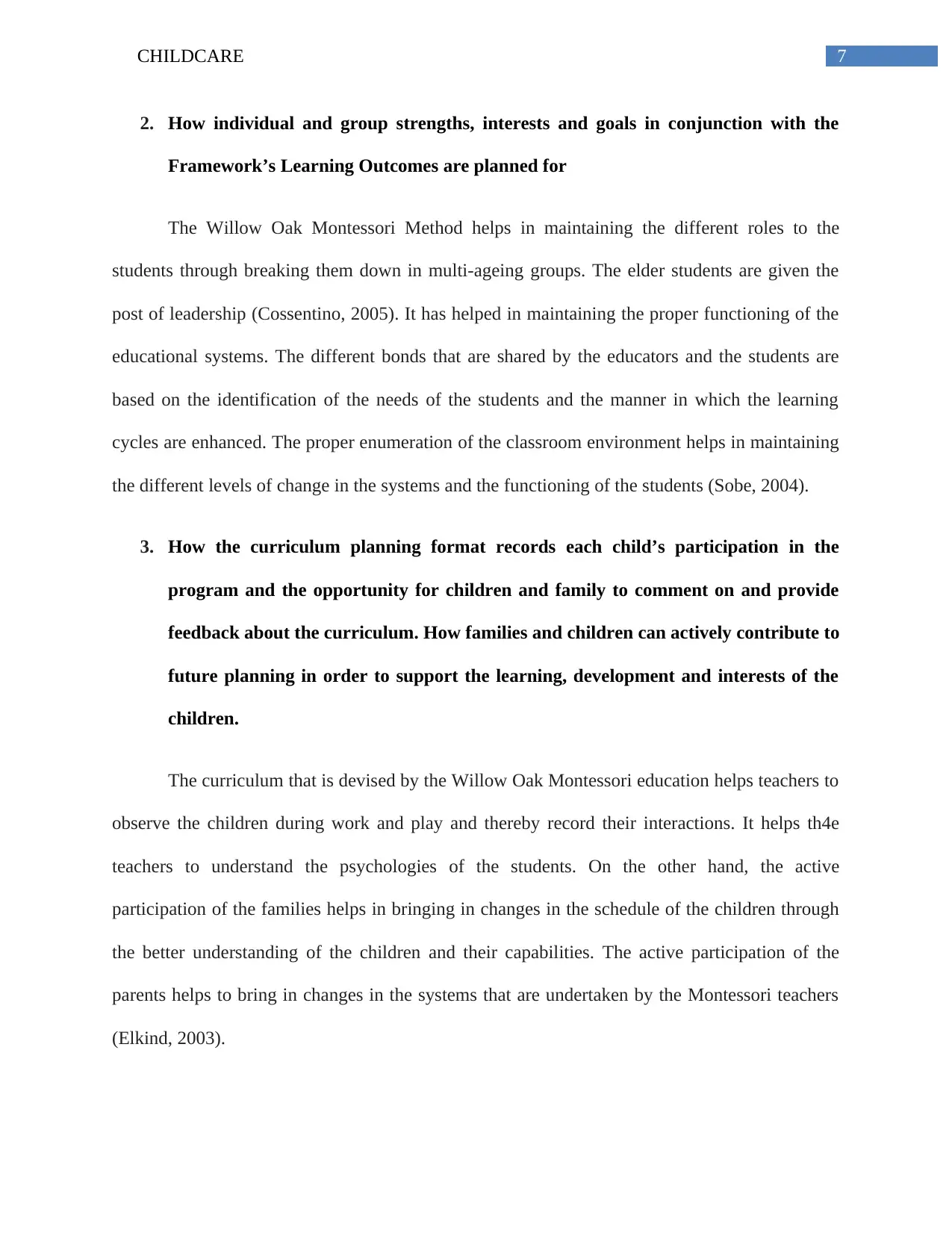
7CHILDCARE
2. How individual and group strengths, interests and goals in conjunction with the
Framework’s Learning Outcomes are planned for
The Willow Oak Montessori Method helps in maintaining the different roles to the
students through breaking them down in multi-ageing groups. The elder students are given the
post of leadership (Cossentino, 2005). It has helped in maintaining the proper functioning of the
educational systems. The different bonds that are shared by the educators and the students are
based on the identification of the needs of the students and the manner in which the learning
cycles are enhanced. The proper enumeration of the classroom environment helps in maintaining
the different levels of change in the systems and the functioning of the students (Sobe, 2004).
3. How the curriculum planning format records each child’s participation in the
program and the opportunity for children and family to comment on and provide
feedback about the curriculum. How families and children can actively contribute to
future planning in order to support the learning, development and interests of the
children.
The curriculum that is devised by the Willow Oak Montessori education helps teachers to
observe the children during work and play and thereby record their interactions. It helps th4e
teachers to understand the psychologies of the students. On the other hand, the active
participation of the families helps in bringing in changes in the schedule of the children through
the better understanding of the children and their capabilities. The active participation of the
parents helps to bring in changes in the systems that are undertaken by the Montessori teachers
(Elkind, 2003).
2. How individual and group strengths, interests and goals in conjunction with the
Framework’s Learning Outcomes are planned for
The Willow Oak Montessori Method helps in maintaining the different roles to the
students through breaking them down in multi-ageing groups. The elder students are given the
post of leadership (Cossentino, 2005). It has helped in maintaining the proper functioning of the
educational systems. The different bonds that are shared by the educators and the students are
based on the identification of the needs of the students and the manner in which the learning
cycles are enhanced. The proper enumeration of the classroom environment helps in maintaining
the different levels of change in the systems and the functioning of the students (Sobe, 2004).
3. How the curriculum planning format records each child’s participation in the
program and the opportunity for children and family to comment on and provide
feedback about the curriculum. How families and children can actively contribute to
future planning in order to support the learning, development and interests of the
children.
The curriculum that is devised by the Willow Oak Montessori education helps teachers to
observe the children during work and play and thereby record their interactions. It helps th4e
teachers to understand the psychologies of the students. On the other hand, the active
participation of the families helps in bringing in changes in the schedule of the children through
the better understanding of the children and their capabilities. The active participation of the
parents helps to bring in changes in the systems that are undertaken by the Montessori teachers
(Elkind, 2003).
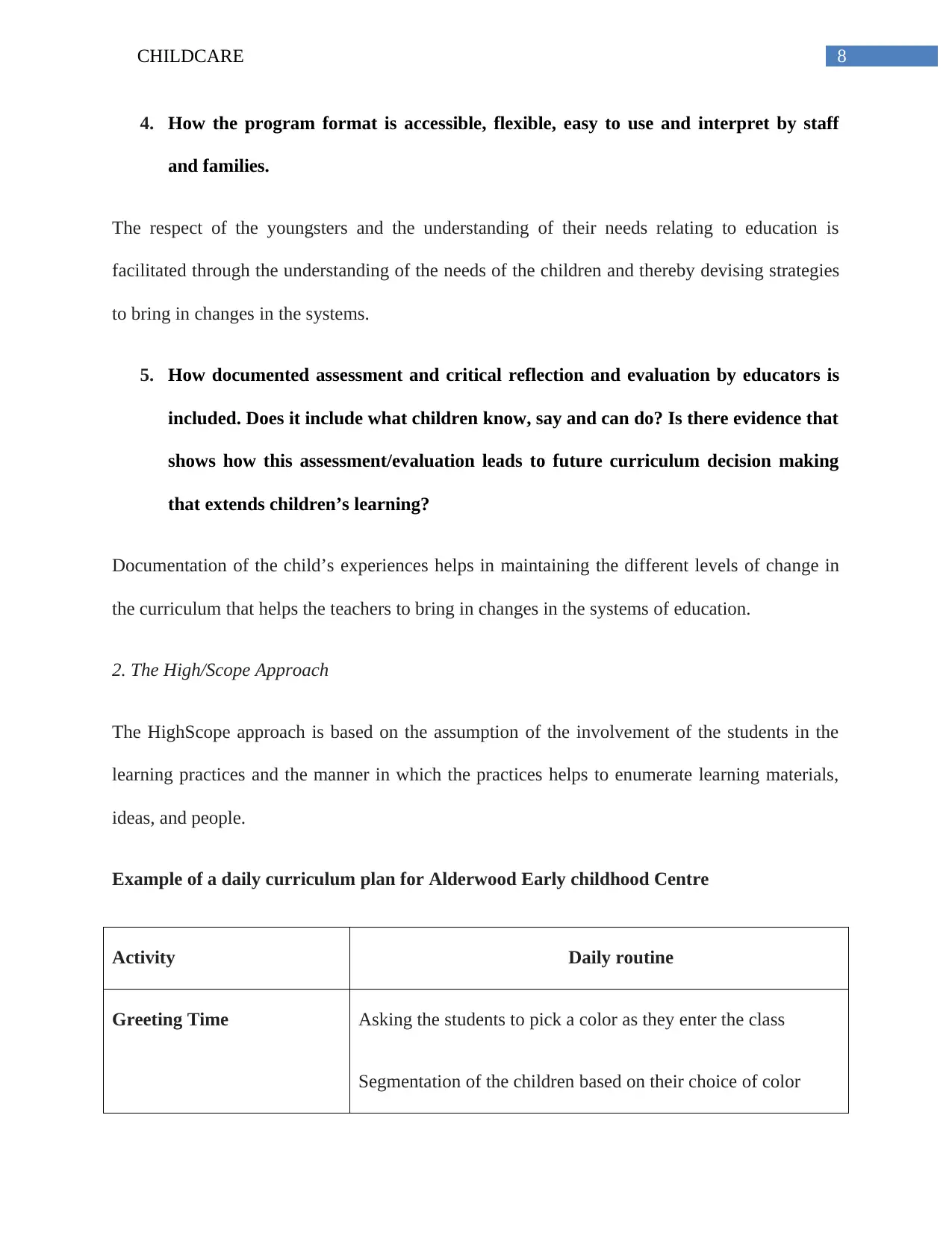
8CHILDCARE
4. How the program format is accessible, flexible, easy to use and interpret by staff
and families.
The respect of the youngsters and the understanding of their needs relating to education is
facilitated through the understanding of the needs of the children and thereby devising strategies
to bring in changes in the systems.
5. How documented assessment and critical reflection and evaluation by educators is
included. Does it include what children know, say and can do? Is there evidence that
shows how this assessment/evaluation leads to future curriculum decision making
that extends children’s learning?
Documentation of the child’s experiences helps in maintaining the different levels of change in
the curriculum that helps the teachers to bring in changes in the systems of education.
2. The High/Scope Approach
The HighScope approach is based on the assumption of the involvement of the students in the
learning practices and the manner in which the practices helps to enumerate learning materials,
ideas, and people.
Example of a daily curriculum plan for Alderwood Early childhood Centre
Activity Daily routine
Greeting Time Asking the students to pick a color as they enter the class
Segmentation of the children based on their choice of color
4. How the program format is accessible, flexible, easy to use and interpret by staff
and families.
The respect of the youngsters and the understanding of their needs relating to education is
facilitated through the understanding of the needs of the children and thereby devising strategies
to bring in changes in the systems.
5. How documented assessment and critical reflection and evaluation by educators is
included. Does it include what children know, say and can do? Is there evidence that
shows how this assessment/evaluation leads to future curriculum decision making
that extends children’s learning?
Documentation of the child’s experiences helps in maintaining the different levels of change in
the curriculum that helps the teachers to bring in changes in the systems of education.
2. The High/Scope Approach
The HighScope approach is based on the assumption of the involvement of the students in the
learning practices and the manner in which the practices helps to enumerate learning materials,
ideas, and people.
Example of a daily curriculum plan for Alderwood Early childhood Centre
Activity Daily routine
Greeting Time Asking the students to pick a color as they enter the class
Segmentation of the children based on their choice of color
⊘ This is a preview!⊘
Do you want full access?
Subscribe today to unlock all pages.

Trusted by 1+ million students worldwide
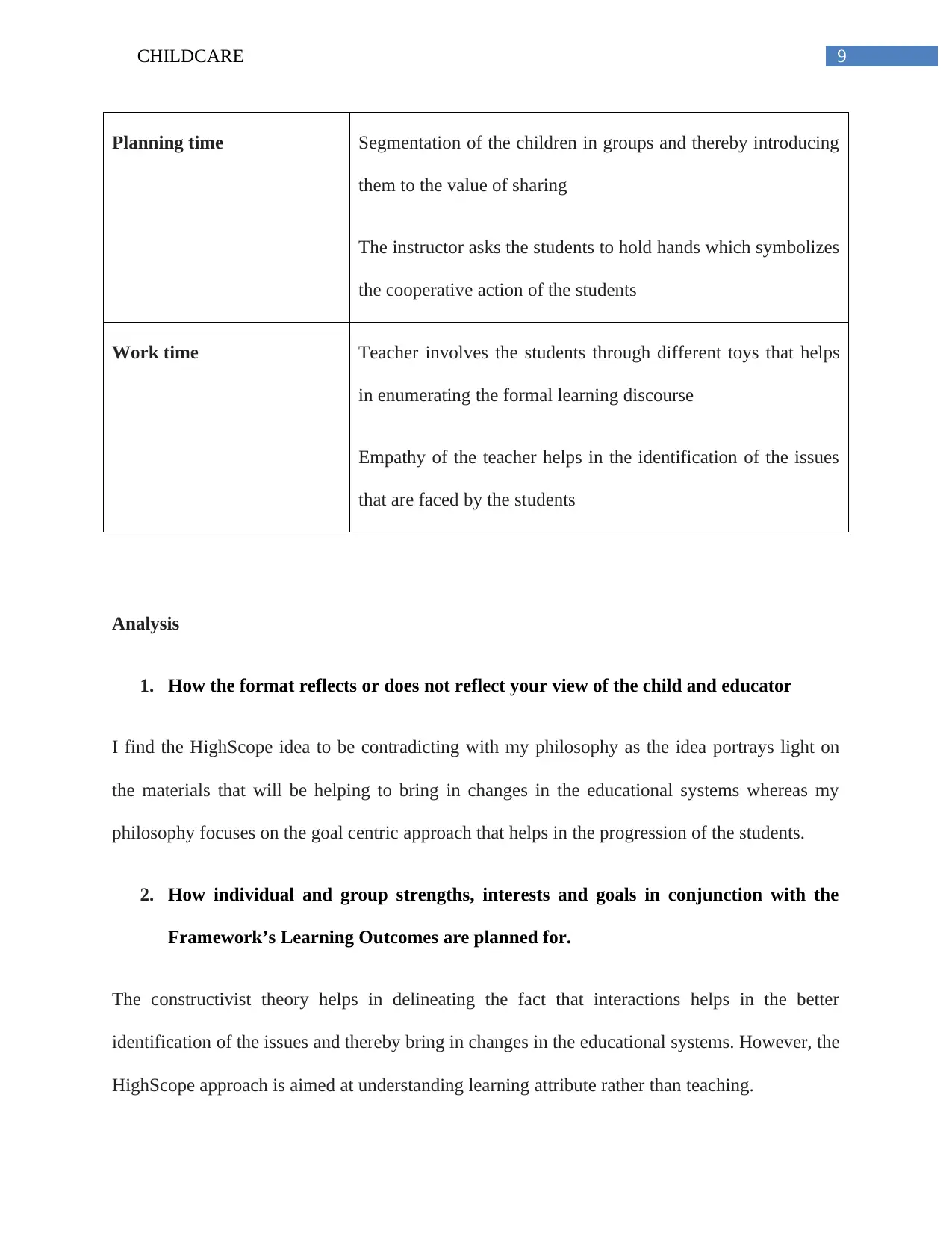
9CHILDCARE
Planning time Segmentation of the children in groups and thereby introducing
them to the value of sharing
The instructor asks the students to hold hands which symbolizes
the cooperative action of the students
Work time Teacher involves the students through different toys that helps
in enumerating the formal learning discourse
Empathy of the teacher helps in the identification of the issues
that are faced by the students
Analysis
1. How the format reflects or does not reflect your view of the child and educator
I find the HighScope idea to be contradicting with my philosophy as the idea portrays light on
the materials that will be helping to bring in changes in the educational systems whereas my
philosophy focuses on the goal centric approach that helps in the progression of the students.
2. How individual and group strengths, interests and goals in conjunction with the
Framework’s Learning Outcomes are planned for.
The constructivist theory helps in delineating the fact that interactions helps in the better
identification of the issues and thereby bring in changes in the educational systems. However, the
HighScope approach is aimed at understanding learning attribute rather than teaching.
Planning time Segmentation of the children in groups and thereby introducing
them to the value of sharing
The instructor asks the students to hold hands which symbolizes
the cooperative action of the students
Work time Teacher involves the students through different toys that helps
in enumerating the formal learning discourse
Empathy of the teacher helps in the identification of the issues
that are faced by the students
Analysis
1. How the format reflects or does not reflect your view of the child and educator
I find the HighScope idea to be contradicting with my philosophy as the idea portrays light on
the materials that will be helping to bring in changes in the educational systems whereas my
philosophy focuses on the goal centric approach that helps in the progression of the students.
2. How individual and group strengths, interests and goals in conjunction with the
Framework’s Learning Outcomes are planned for.
The constructivist theory helps in delineating the fact that interactions helps in the better
identification of the issues and thereby bring in changes in the educational systems. However, the
HighScope approach is aimed at understanding learning attribute rather than teaching.
Paraphrase This Document
Need a fresh take? Get an instant paraphrase of this document with our AI Paraphraser
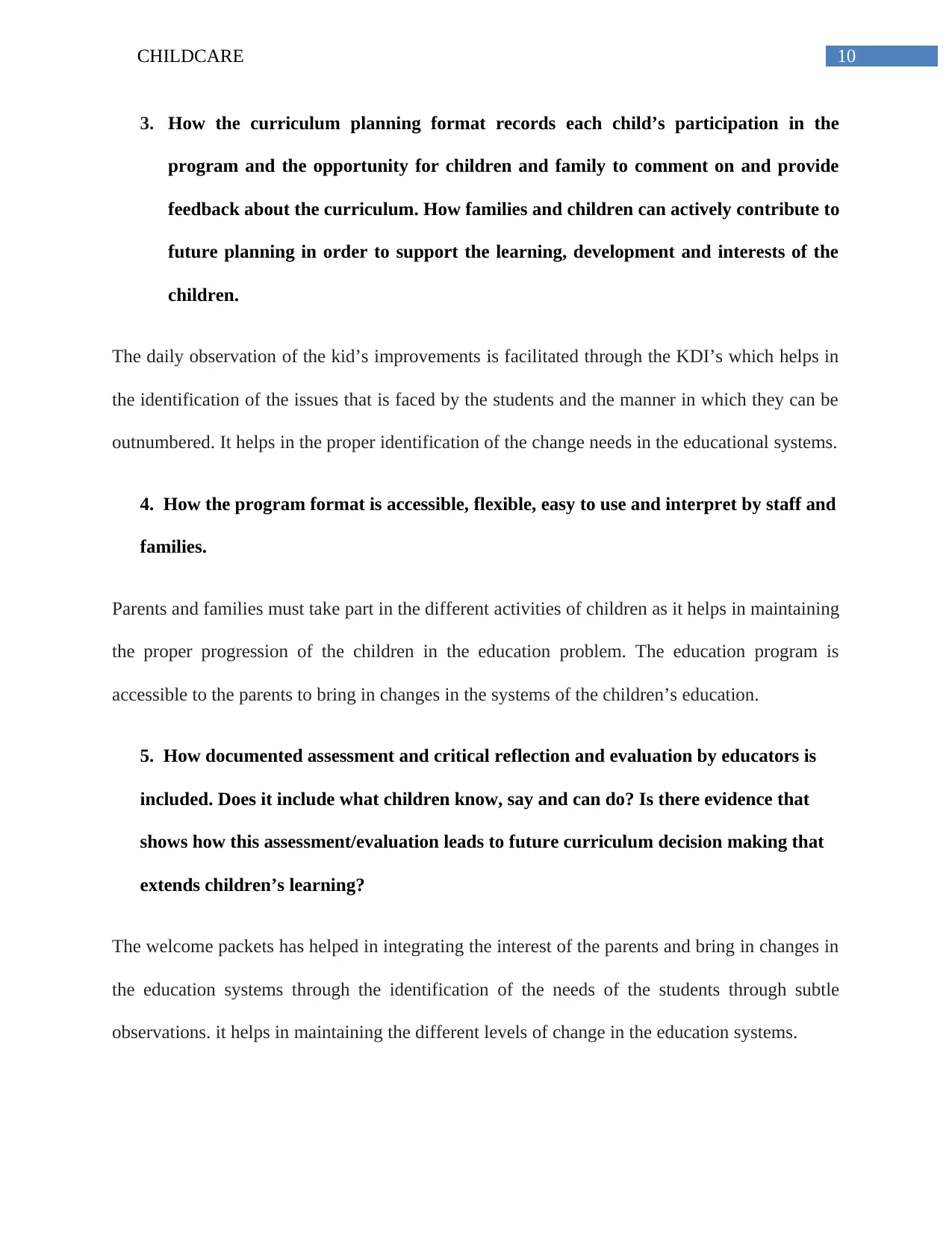
10CHILDCARE
3. How the curriculum planning format records each child’s participation in the
program and the opportunity for children and family to comment on and provide
feedback about the curriculum. How families and children can actively contribute to
future planning in order to support the learning, development and interests of the
children.
The daily observation of the kid’s improvements is facilitated through the KDI’s which helps in
the identification of the issues that is faced by the students and the manner in which they can be
outnumbered. It helps in the proper identification of the change needs in the educational systems.
4. How the program format is accessible, flexible, easy to use and interpret by staff and
families.
Parents and families must take part in the different activities of children as it helps in maintaining
the proper progression of the children in the education problem. The education program is
accessible to the parents to bring in changes in the systems of the children’s education.
5. How documented assessment and critical reflection and evaluation by educators is
included. Does it include what children know, say and can do? Is there evidence that
shows how this assessment/evaluation leads to future curriculum decision making that
extends children’s learning?
The welcome packets has helped in integrating the interest of the parents and bring in changes in
the education systems through the identification of the needs of the students through subtle
observations. it helps in maintaining the different levels of change in the education systems.
3. How the curriculum planning format records each child’s participation in the
program and the opportunity for children and family to comment on and provide
feedback about the curriculum. How families and children can actively contribute to
future planning in order to support the learning, development and interests of the
children.
The daily observation of the kid’s improvements is facilitated through the KDI’s which helps in
the identification of the issues that is faced by the students and the manner in which they can be
outnumbered. It helps in the proper identification of the change needs in the educational systems.
4. How the program format is accessible, flexible, easy to use and interpret by staff and
families.
Parents and families must take part in the different activities of children as it helps in maintaining
the proper progression of the children in the education problem. The education program is
accessible to the parents to bring in changes in the systems of the children’s education.
5. How documented assessment and critical reflection and evaluation by educators is
included. Does it include what children know, say and can do? Is there evidence that
shows how this assessment/evaluation leads to future curriculum decision making that
extends children’s learning?
The welcome packets has helped in integrating the interest of the parents and bring in changes in
the education systems through the identification of the needs of the students through subtle
observations. it helps in maintaining the different levels of change in the education systems.
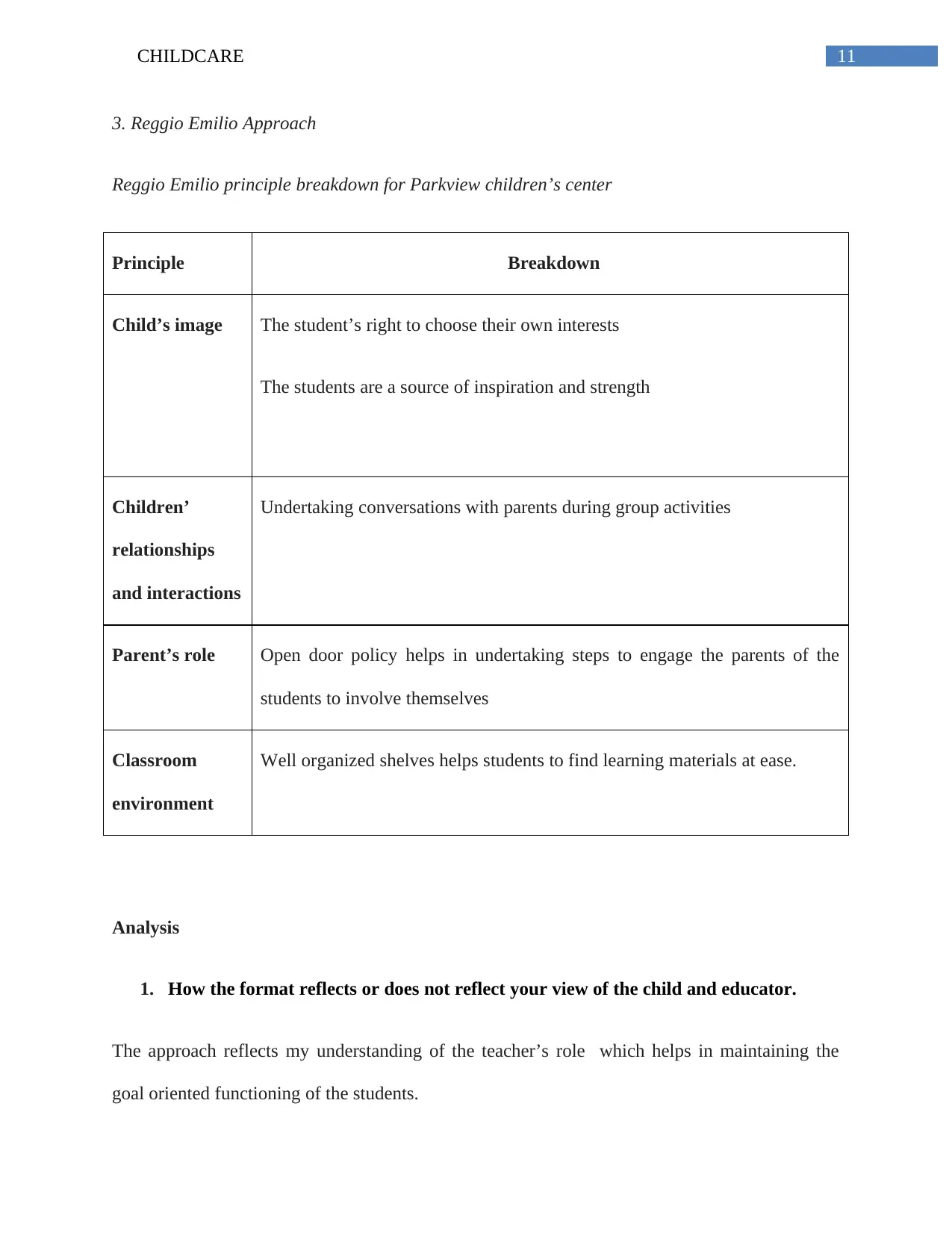
11CHILDCARE
3. Reggio Emilio Approach
Reggio Emilio principle breakdown for Parkview children’s center
Principle Breakdown
Child’s image The student’s right to choose their own interests
The students are a source of inspiration and strength
Children’
relationships
and interactions
Undertaking conversations with parents during group activities
Parent’s role Open door policy helps in undertaking steps to engage the parents of the
students to involve themselves
Classroom
environment
Well organized shelves helps students to find learning materials at ease.
Analysis
1. How the format reflects or does not reflect your view of the child and educator.
The approach reflects my understanding of the teacher’s role which helps in maintaining the
goal oriented functioning of the students.
3. Reggio Emilio Approach
Reggio Emilio principle breakdown for Parkview children’s center
Principle Breakdown
Child’s image The student’s right to choose their own interests
The students are a source of inspiration and strength
Children’
relationships
and interactions
Undertaking conversations with parents during group activities
Parent’s role Open door policy helps in undertaking steps to engage the parents of the
students to involve themselves
Classroom
environment
Well organized shelves helps students to find learning materials at ease.
Analysis
1. How the format reflects or does not reflect your view of the child and educator.
The approach reflects my understanding of the teacher’s role which helps in maintaining the
goal oriented functioning of the students.
⊘ This is a preview!⊘
Do you want full access?
Subscribe today to unlock all pages.

Trusted by 1+ million students worldwide
1 out of 23
Related Documents
Your All-in-One AI-Powered Toolkit for Academic Success.
+13062052269
info@desklib.com
Available 24*7 on WhatsApp / Email
![[object Object]](/_next/static/media/star-bottom.7253800d.svg)
Unlock your academic potential
Copyright © 2020–2025 A2Z Services. All Rights Reserved. Developed and managed by ZUCOL.





